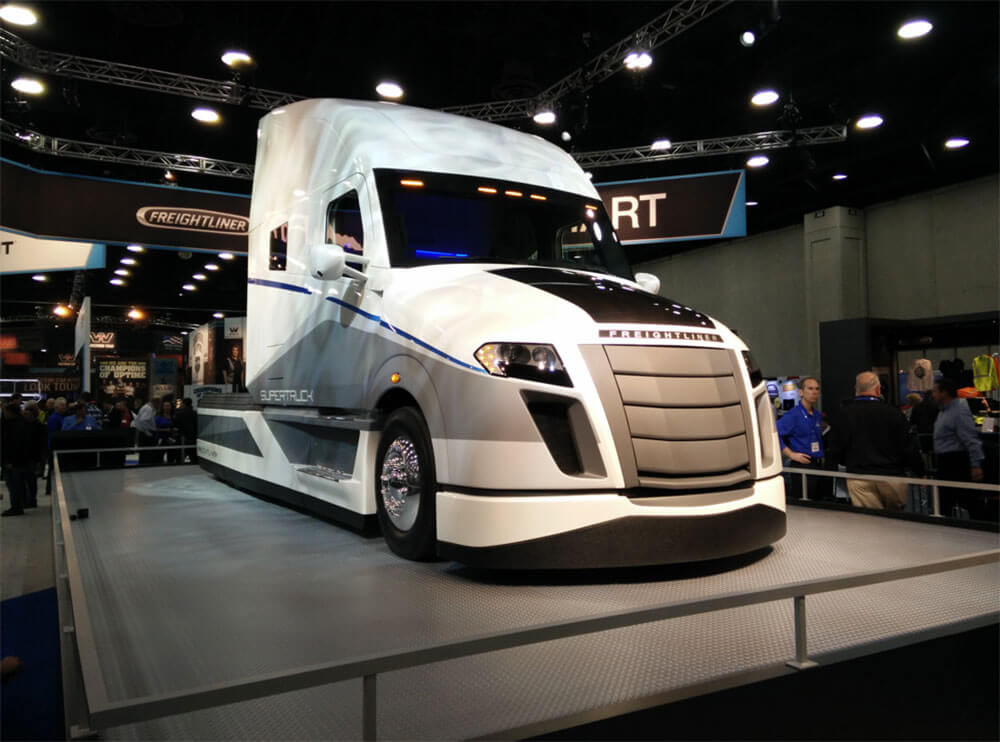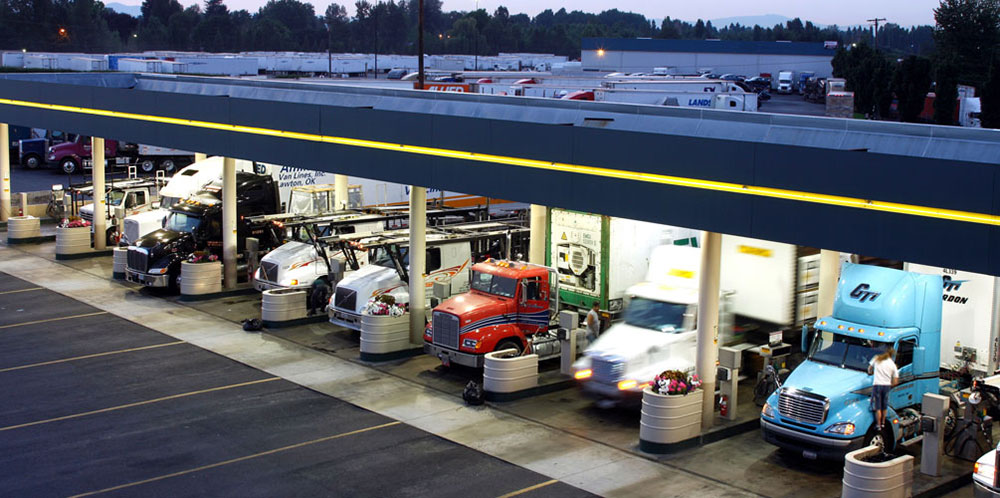The Road Ahead: Trucking in 2018

Technological advancements of recent years have disrupted industries across the globe, and the commercial trucking industry is no exception. However, based on expert projections so far, it looks like things will certainly be looking up in the year to come and, if companies are predicting it right, 2018 should see some of the most impressive technological additions for the business
You Might Not Notice New Models
Plenty of truck models will be getting a makeover this year and some new additions will be added to the long lineup of options as commercial truck manufacturers work to deploy new tech and features.
In fact, you shouldn’t be judging a book by its cover when it comes to 2018 models. While, on the outside, they may not look too different, they have a lot more to offer under-the-hood. If you’re shopping for a new truck model, you should take note that manufacturers are focused on adding built-in remote diagnostic capabilities and other “hidden” features.
Forget The Frills
Unlike the consumer car market where manufacturers are focused on updating interior spaces and re-doing their model designs every few years to remain different and cutting edge, don’t expect to see such updates for the commercial trucking industry in 2018.
Rather than trying to keep exterior body styles new and interior looks fresh, commercial truck manufacturers have instead committed to an approach of leaving what works alone and focusing on the areas where improvements can really be made.
Diesel Today, Electric Tomorrow
Among these less-apparent upgrades is the alternative fuel package that enables certain truck models to be recgonifgured so they can run on CNG (Compressed Natural Gas), propane, electricity, or something other than gasoline or diesel. General Motors is one company that’s pushing for this addition in 2018 and beyond.
The great thing about this feature is that it enables fleet owners to make a solid investment that won’t be made obsolete or too costly when electric cars begin hitting the road on a larger scale in the near future.
Suppose U Drive leases out trucks that include Electric, Hybrid, & CNG power. Check out our fleet!

Technology Will Propel The Industry Forward
Technology has already made a huge impact on the commercial trucking industry in recent years, but new technology will help make the road safer and easier to travel for everyone.
Here’s a sneak peek at some of the technology that you might have added to your fleet in 2018:
- Telematics: Telematics is basically an “enabler” of other technology. There has been an explosion of apps in this fast-growing sector, and it will help improve vehicle-to-vehicle communication, act as a platform for new trucking systems, and increase safety overall.
- Safety Tech: Speaking of safety, this happens to be one of the biggest focuses of tech development within the industry. Anti-lock braking systems, lane departure warnings, stability control, collision avoidance systems, blind spot warnings, rear view cameras, side monitor cameras, sensors, and more will help keep truckers safer.
- Fuel Efficiency: Tesla is expected to release its first electric semi-truck this year, and many others are tagging along in an effort to reduce fuel intake through aerodynamic improvements that will, ultimately, lower fuel intake, environmental impact, and costs.
With safety as a top priority, Suppose U Drive offers new truck models that incorporates telematics, collision avoidance systems, and safety cameras. Check out our fleet!

Other Trends To Watch For
With about 70% of freight in the United States traveling by truck at some point on its journey from factory to consumer, ATA expects the trucking industry to remain the dominant carrier for freight through 2018 and beyond.
Commercial trucks move about 10.5 billion tons of freight each year, and that number is going up.
This number, combined with the fact that the economy is growing and future projections are great, means that drivers should expect greater job stability than in years prior while potential employees will see more and more spots open up. In fact, one of the trends you’ll likely see mentioned the most throughout the year is the fact that the industry doesn’t have enough drivers to handle the workload.
The ATA says that the industry is short around 30,000 drivers, and unless more people begin jumping on board, this statistic is projected to reach a number of 245,000 by 2022. In other words, the industry is growing fast!
“On average, trucking will need to recruit nearly 100,000 new drivers every year…”
Consumer demand is continuing to grow and more people want more things from companies, which means more work for the people shipping those things.
To help fill in the driver gap, the ATA says companies might begin employing planes and railways to get things from Point A to Point B, but they say getting these items from Point B (the port, station, or terminal) will still require a truck so the items can reach their final destination at Point C (the store or customer).
So, while other industries are able to step in and assist with this growing demand at some stages of the journey, they won’t be able to completely fulfill the needs of the industry. Trucks will remain the go-to for getting things to and from their final destination. This fact, combined with increased expenses for the industry, means that fleet owners will likely have to mitigate these problems by raising drivers’ salaries.
Truckers should expect their wages to increase substantially.
We all know the secret of the economy: when demand increases and supply is low, price goes up. Due to the shortage of truckers, those working in the industry should expect to see a pleasing increase in their salaries through 2018.
This comes as fantastic news for drivers, especially after the industry has been plagued by years of stagnant wages. And, it’s not just going to be a one-off ordeal.
Since the industry is projected to grow significantly in 2018 and beyond, these raises are likely to provide a stable source of income growth for truckers and their families. Some industry projection say that, over the next two years, drivers can expect their wages to nearly double.
Driver wages could climb by 30% to 40% in the next two years.
This news will not only lead to better compensation for truckers in the industry now, it will also help end the shortage faster by making the job more appealing to potential employees. Along with the raise, the quality of benefits offered with a career in trucking is also expected to improve as companies are beginning to offer better insurance and time off for workers.
In addition to all of this, though, there’s another big change that may be coming for the industry. While employees grow excited for the potential of how much they may be getting paid soon, they might also be seeing changes in how they are being paid.
Truckers should also anticipate other changes in their paycheck.
With the new ELD regulations and more emphasis being placed on how many hours truckers are working, industry experts say it’s only logical to switch from per-load payment to an hourly rate within the next ten years.
Although this change may raise the cost of shipping for manufacturers that in itself is expected to help level out the issue of driver shortages and, more importantly, help better compensate truckers by finally paying them for the time they spend driving rather than on a “fee per mile” basis that often led to poor compensation, long hours, and tired drivers.
Experts project it will be somewhere within the next 10 years, but some companies may already begin transitioning to this structure in 2018 in an attempt to keep the drivers they do have happy. And, on that note, trucking unions have taken note that 2018 would be a good year for negotiations.
Unions can ask for more in 2018.
Due to the dire shortage of truckers, companies will be doing a lot to keep their drivers happy through 2018 and beyond. That means that unions can leverage this opportunity to begin asking for better benefits and other improvements that they might have feared requesting just a year or two back. As a whole, this will lead to multiple industry improvements.

Truck Sales Will Surge As A Result
Looking back, 2017 proved to be one of the best years yet for the trucking industry as it roared through the year, being boosted by an improving economy and growing freight demand and manufacturing.
ACT Research confirmed that the heaviest truck sales increased 59% throughout last year, surpassing a quarter million new sales in Class 8 weight trucks alone. These statistics demonstrate how much the trucking industry in North America is benefiting from innovation within the industry and an ever-increasing demand for freight transport.
This is further proved by the fact that, in December, there were about nine loads for every available truck in the spot freight market. That number is the highest monthly average ever recorded by DAT, and this figure makes demand 139% higher than it was in December 2016.
All of this and more has led industry experts to being quite enthused about the year ahead, with projections saying that Class 8 trucks and other segments’ sales will continue to grow at a rate of around 19%. Due to this growth, truck manufacturers are pressing to get more trucks out on the market while fleet owners continue their search for more drivers.
While this news means that there are some hurdles fleet owners and manufacturers should plan to face in the new year, the demand for drivers is not going down anytime soon. Because of that, drivers will be able to benefit through increased wages and even better benefits.
In other words, all signs point that 2018 is expected to be one of the best years yet for the commercial trucking industry.
View our fleet and ask about our lease/rental options to bring your business’ equipment up-to-date. At Suppose U Drive, we follow every trucking trend to ensure we are always offering the best possible service.

